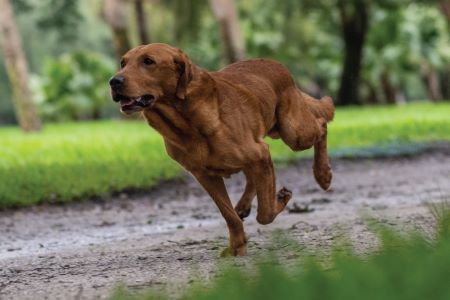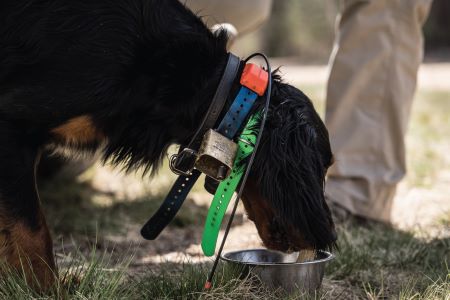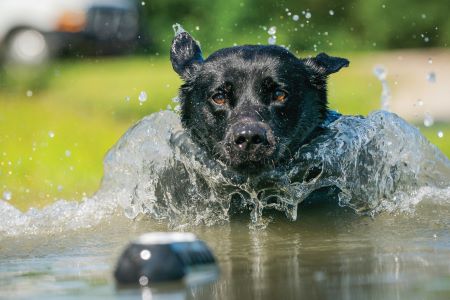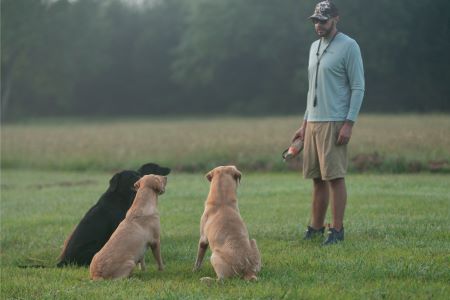Help Keep Your Dog Running Cool During Preseason Training

Preseason training often requires upland and waterfowl hunters to work dogs when it’s really hot and humid. Fortunately, there are several workarounds to help safeguard hunting dogs during summer sessions.
This article is in partnership with Eukanuba™ Premium Performance Dry Dog Food
Help Keep Your Dog Running Cool During Preseason Training
Written by Tom Keer
Preseason training often requires upland and waterfowl hunters to work dogs when it’s really hot and humid. Fortunately, there are several workarounds to help safeguard hunting dogs during summer sessions.
How Dogs Cool
According to Russ Kelley, the Scientific Services Nutritionist at Eukanuba’s™ Pet Health and Nutrition Center, “Dogs reduce body heat in a variety of ways. 70 percent of a dog’s heat is dissipated through their skin.1 But intense heat and humidity means the dog’s core body temperature is close to the ambient temperature so they don’t cool off easily. Breezes usually help, but in the summer the winds are typically very light. Dogs also cool by panting, which is the exchange of internal air for external air. During hunting season, hot internal air is traded for cool external air, and dogs can better regulate their temperature. But in the summer, hot internal air is replaced with hot external air, so minimal cooling occurs. Dogs also perspire, and they do it through their noses and pads. The nose is a small surface area and oftentimes pads are calloused from training, so neither allows for enough heat to escape. Dogs can also lower their body temperatures by lying on a cool surface, but in the summer even shady areas have hot ground. It’s hard for dogs to stay cool when working in the summer, so it’s up to handlers to keep them safe.”

When Dogs Overheat
When a dog’s activity causes his body to generate more heat than he can dissipate he’s at risk of developing exertional Heat Related Illness (HRI). There are three phases to HRI: heat stress, heat exhaustion and heat stroke. Signs of heat stress show when dogs lose focus, are visibly tired, pant heavily, or have white, pasty saliva in their gums. With heat exhaustion, they might stumble or stagger, can be mentally alert but too tired to physically respond or pant uncontrollably. Heat stroke is dangerous, and dogs may vomit, have diarrhea, or collapse. There are other signs, and owners who recognize them are better equipped to help get their dogs the help they need. Learn more about the signs and actions to take at EukanubaSportingDog.com/HRI.
Some Dogs are at Greater Risk of External HRI
Overweight dogs run a greater risk of exertional HRI than those with an ideal weight. Sedentary dogs that are unconditioned and then called to work without being acclimated to the hot temperatures can be at an increased risk, too. Older dogs, especially those with health conditions, can be impacted. But keep an eye on young dogs as well because they’re hard charging and don’t always know their limits.

Here are Some Tips to Help Keep Dogs Cool
Fighting Weight: Start with a weigh-in and assess your dog’s body condition score. Overweight dogs should shed some pounds before exercising in the heat.
Acclimate Slowly: Dogs that live indoors get used to air conditioning. Prepare your dog for summer work by slowly acclimating him to the increasing outdoor temperatures.
Hydrate: Lots of cool, fresh water is a must. But how much? A 44-pound dog can lose between .5 and 1.5 gallons of water per day depending on their activity and the environmental conditions.2 At a minimum, an active dog should consume as much water as they’re losing and more when running in the heat. If you’re not sure how much water your dog should drink then one gauge is three times the amount of dry food you feed.
Prehydration: Prehydrate dogs a few days before outside activity by adding water to his dry kibble. Feed immediately as some dogs don’t like mushy kibble. Another method is water baiting, which is done by adding a tablespoon of wet dog food to a water bowl. Dogs trying to get the food will drink more water.

Progressive Conditioning: Begin with a progressive workout program. Understand your dog’s natural abilities and push only as hard as he can handle. Gradually increase the time and intensity as his endurance improves.
Swim: Incorporate water and swimming into your preseason conditioning program. Not only will dogs get a great work out but the water also lowers core body temperatures faster than air.
Assess the Weather: Use the 140 Rule of Thumb. Add the temperature to the humidity percentage, and if it’s over 140 you might wait until it’s cooler. Also, watch the heat index and be careful if it exceeds 75.

Assess the Terrain: Some environments can cause dogs to work harder. Running in sand, through mud, at high elevation, or in loose shale can be more challenging than running on a flat, grass field. And areas like thick grasses or dense covers have limited air circulation.
Take Frequent Breaks: Take a break every half hour or so to let your dog rest in the shade and hydrate. The ideal resting spot also has a breeze which helps dogs cool.
Educate Yourself: Knowing how to tell if your dog is overheating and what to do is critical. Learn more about exertional HRI, how to recognize the signs and what steps to take if your dog overheats at EukanubaSportingDog.com/HRI.
This summer, make the most of your preseason training by taking steps to help keep your dog cool. Know the signs of overheating and how to help keep him safe and running strong. After all, Opening Day is not far away.
1 Bruchim Y, Horowitz M, Aroch I. Pathophysiology of heatstroke in dogs – revisited. Temperature (Austin). 2017;4(4):356-370. Published 2017 Oct 9. doi:10.1080/23328940.2017.1367457 (https://www.ncbi.nlm.nih.gov/pmc/articles/PMC5800390/)
2 https://www.workingdogmagazine.com/fueling-performance-keep-your-dog-hydrated/
Tom Keer is an award-winning writer and regular contributor to over a dozen magazines and blogs. His favorite time of year is in October and November where you can find him in woodcock and grouse coverts or quail fields with his wife, two kids, and three English setters. Visit him at www.tomkeer.com or at www.thekeergroup.com.

Tom Keer is an award-winning writer and regular contributor to over a dozen magazines and blogs. His favorite time of year is in October and November where you can find him in woodcock and grouse coverts or quail fields with his wife, two kids, and three English setters. Visit him at www.tomkeer.com or at www.thekeergroup.com.


Comments